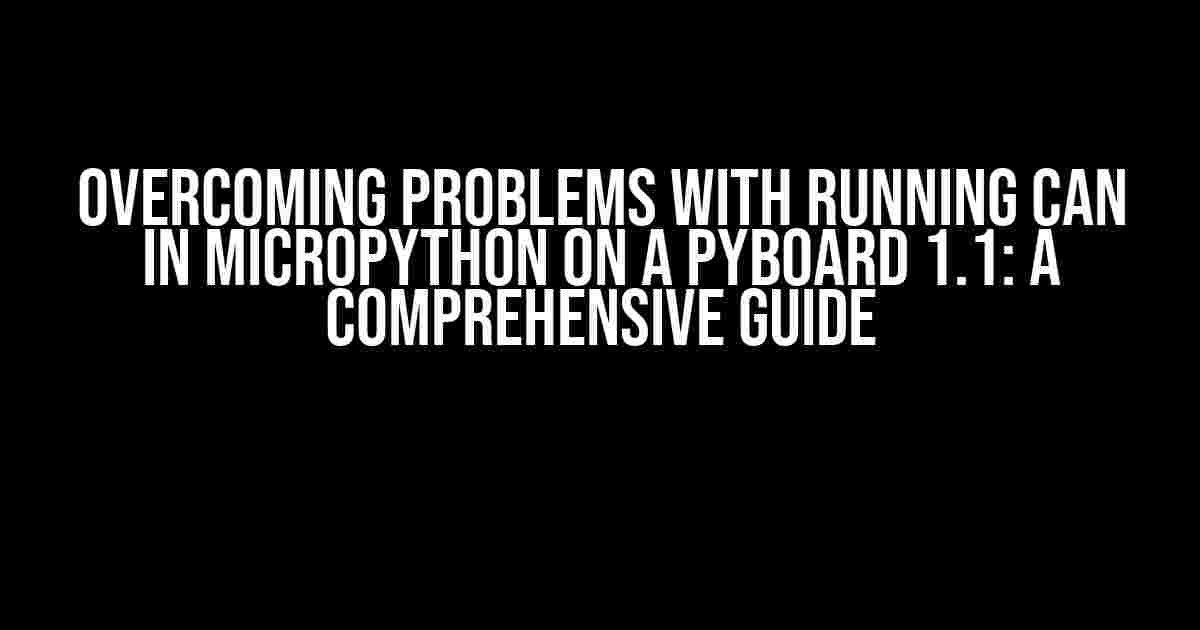Are you struggling to get CAN (Controller Area Network) up and running on your Pyboard 1.1 using Micropython? You’re not alone! Many developers have faced issues with implementing CAN on this popular microcontroller board. In this article, we’ll delve into the common problems you might encounter and provide step-by-step solutions to get you back on track.
Problem #1: CAN Module Not Found
One of the most frustrating errors you might encounter is the “CAN module not found” error. This typically occurs when Micropython can’t locate the CAN module, which is essential for communicating with the CAN bus.
Solution:
To resolve this issue, ensure you have the latest version of Micropython installed on your Pyboard 1.1. You can check the version by running:
import sys
print(sys.version)If you’re running an older version, update Micropython to the latest version using the following steps:
- Download the latest Micropython firmware from the official website.
- Connect your Pyboard 1.1 to your computer using a USB cable.
- Open a terminal or command prompt and navigate to the folder containing the downloaded firmware.
- Run the following command to update the firmware:
dfu-util -a 0 -s 0x08000000:leave -D pybv11.binOnce the update is complete, restart your Pyboard 1.1 and try running the CAN module again.
Problem #2: CAN Bus Not Initialized
Another common issue is failing to initialize the CAN bus properly. This can occur due to incorrect configuration or mismatched baud rates.
Solution:
To initialize the CAN bus correctly, follow these steps:
- Import the CAN module and create a CAN object:
import can
can_obj = can.CAN(1, pins=("Y3", "Y4"))Note: Pin assignments may vary depending on your Pyboard 1.1 setup. Consult the official documentation for correct pin mappings.
- Set the baud rate to match your CAN bus configuration:
can_obj.init(mode=can.MODE_NORMAL, baudrate=500000)In this example, we’re setting the baud rate to 500 kbps, which is a common value for many CAN bus systems. Adjust this value according to your specific requirements.
Problem #3: CAN Message Transmission Issues
After initializing the CAN bus, you might encounter issues with transmitting CAN messages. This can be due to incorrect message formatting or failing to specify the correct message ID.
Solution:
To transmit CAN messages successfully, follow these guidelines:
- Define the message ID and data:
msg_id = 0x123 # Replace with your message ID
msg_data = [0x01, 0x02, 0x03, 0x04, 0x05, 0x06, 0x07, 0x08]- Create a CAN message object:
msg = can.Message(arbitration_id=msg_id, data=msg_data)- Send the message using the CAN object:
can_obj.send(msg)Remember to replace the message ID and data with values specific to your CAN bus application.
Problem #4: CAN Bus Off Status
In some cases, the CAN bus might enter an “off” state, preventing any further communication. This can occur due to errors during transmission or reception.
Solution:
To recover from a CAN bus “off” state, follow these steps:
- Check the CAN bus status:
print(can_obj.state)This will display the current state of the CAN bus. If it’s in an “off” state, proceed to the next step.
- Reset the CAN bus:
can_obj.reset()This will reset the CAN bus and restore communication.
Problem #5: Pyboard 1.1 Pinouts and Wiring
Incorrect pinouts and wiring can lead to CAN bus communication issues. Ensure you have the correct pin assignments and wiring configuration.
Solution:
Consult the official Pyboard 1.1 documentation for correct pin assignments and wiring schematics. For CAN bus communication, you’ll typically need to connect:
| Pin | Function |
|---|---|
| Y3 | CAN TX |
| Y4 | CAN RX |
Double-check your wiring and pin assignments to ensure they match the official documentation.
Conclusion
By following this comprehensive guide, you should be able to overcome common problems with running CAN in Micropython on a Pyboard 1.1. Remember to update your Micropython firmware, initialize the CAN bus correctly, format CAN messages properly, and troubleshoot issues related to the CAN bus “off” state and pinouts. With these solutions, you’ll be well on your way to successfully implementing CAN communication on your Pyboard 1.1 project.
Happy coding!
Here are 5 Questions and Answers about “Problems with running CAN in Micropython on a pyboard 1.1” in a creative voice and tone:
Frequently Asked Question
Are you facing some frustrating issues with running CAN in Micropython on your pyboard 1.1? Worry no more! We’ve got you covered with these frequently asked questions and answers.
Why am I not able to import the CAN module in Micropython?
This is a common issue! Make sure you have enabled the CAN bus on your pyboard 1.1 by adding `can = CAN(1, bitrate=500000)` in your `boot.py` file. Also, ensure that you have updated your Micropython firmware to the latest version.
How do I configure the CAN bus on my pyboard 1.1?
Easy peasy! You can configure the CAN bus using the following code: `can = CAN(1, bitrate=500000, extframe=False, mode=CAN.NORMAL)` in your `boot.py` file. This sets the bitrate to 500 kbps and enables normal operation mode.
Why is my CAN bus not transmitting data?
Hmm, that’s frustrating! Check if your CAN transceiver is properly connected and powered. Also, ensure that you have initialized the CAN bus correctly using `can.init(mode=CAN.NORMAL)` and that you are sending data using `can.send()`.
How do I receive CAN data in Micropython?
Receiving data is a breeze! Use `can.recv()` to receive CAN frames. You can also use `can.recv(0)` to receive all available frames. Make sure to check the return value for errors and handle them accordingly.
What are some common errors I might encounter while running CAN in Micropython?
Don’t worry, we’ve got you covered! Some common errors include bus-off errors, CRC errors, and timeout errors. Check the CAN bus documentation and error codes for more information. Additionally, ensure that your CAN transceiver is properly connected and powered.
We hope these questions and answers helped you resolve your issues with running CAN in Micropython on your pyboard 1.1. Happy coding!
